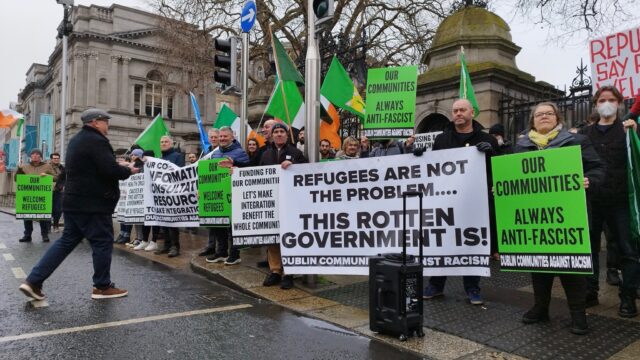The Gaels Strike Back

Joakim Andersen explores the fury and logic behind the latest Irish protests against the Great Replacement, suggesting that the need for accurate and compelling metapolitical vocabulary will prove decisive to framing the new struggles for popular sovereignty across the West.
Over the past week, Dublin has been shaken by protests against immigration policy which, among other things, has led to an asylum‑seeker now standing charged with the rape of a 10‑year‑old girl. Dramatic scenes have spread on social media, including local women berating the police, the Gardaí, Irishmen on horseback attacking police lines, and the police brutally clamping down on the demonstrators.
If it were not precisely because the protests are about the consequences of immigration, they would have been irresistible to large sections of the left, since they include everything from police brutality and riots to ordinary Irish people and hard‑line republican groups like the IRSP. To quote Engels, “Irishmen – wild, headstrong, fanatical Gaels. If one has not seen the Irish, one does not know them. Give me two hundred thousand Irishmen and I could overthrow the entire British monarchy.”
The establishment has tried in concert to stifle the popular resistance to uncontrolled migration policy, among other ways by police violence and by the media both outing riot‑makers with their names, pictures, and addresses and downplaying the rape which triggered it all.
What the riots in Dublin remind us of is not least the Irish people’s unusual conditions in the face of the consequences of population replacement. They are one of the few peoples in Europe with a colonial history, which gives them a good opportunity to understand what is going on, and a history of resistance. The use of the term “plantations” to describe the various “refugee accommodations” that are placed in unwilling local communities is an expression of this, and explicitly ties back to how population transfers have historically been used as a weapon.
At the same time, Irish nationalism has come to be represented not least by left‑nationalists, comparable to the Basque Country and Wales, something which is both a strength and a weakness. Sinn Féin has quickly adopted woke trends regarding immigration, among other things, yet during the protests we have been able to see how smaller groups of republicans, such as the Irish Republican Socialist Party and Fronta Poblachtach have taken the side of the people.
Regardless of what one otherwise thinks about the Marxist IRSP and their history, their analysis of immigration is one of the foremost within today’s left. Their starting point is that the people should own the country: “we declare that the Nation’s sovereignty extends not only to all men and women of the Nation, but to all its material possessions, the Nation’s soil and all its resources, all the wealth and all the wealth‑producing processes within the Nation.” When that is not the case, immigration policy is designed in a way that benefits other actors at the people’s expense: “Irish workers who do try to challenge wages, rent or conditions, can be threatened with replacement by a foreign worker.” The IRSP also analyzes how capitalists’ interests shape different political groups, including “anti‑fascists” but also critics of immigration who are really not very interested in reducing immigration or criticizing the system (“this is why so many politicians elected on the promise of reducing immigration ultimately do nothing”).
At the same time, the IRSP and several other actors remind that organizing and class/people‑consciousness have a temporal dimension. The Irish establishment has had several years to design the immigration policy which is now being directed against the people, but the people have only recently begun to act fully. There are individuals such as Keith Woods and Conor MacGregor, smaller groups such as Fronta Poblachtach and the National Party (An Páirtí Náisiúnta), and there is popular discontent, but so far there are no large institutions or organisations. It is also unclear to what extent the resistance reaches the middle strata: to a large extent, it seems to be a working‑class phenomenon (the contempt for class is also clear in the criticism of the protests on social media, where “unemployed” is used as an insult).
For now, the protests can be likened to post‑modern peasant uprisings: they flare up at intervals, but they struggle to effectively besiege the elite’s fortified centres (physically then, today rather metapolitically). At the same time, Ireland has special conditions given the people’s history and strong organic communities and local societies; the time aspect can also in some respects play into the people’s hands. Not least since population replacement has proceeded so quickly in Ireland that it has become extraordinarily clear to the people (the rest of the West’s experiences of mass immigration are also relatively well‑known).
In terms of language policy, the events in Ireland also underscore the need for a metapolitical vocabulary to describe the background and compare handy concepts, such as anarcho‑tyranny and the Great Replacement. The popular common‑sense describes it aptly: “those in power bring in and support men from all over the world and now they harass women and children and we do not want such ‘accommodations’ near our homes and our children’s schools.”
One possible formulation for other contexts could be that the Irish elite, for politico‑economic reasons, are importing and maintaining a fuidhir (a manual laborer without property) class of foreign men. The concept of folkhem (a nation designated for its own people) implicitly assumes that the people own their home, and the import of a fuidhir class aims to break, delegitimize, and render impossible that relationship. “The aim of immigration was never that the immigrants should become Irish but that the Irish should become immigrants,” so to speak. Instead of a horizontal, organic, mutual relationship between people and elite (“people community”) one is pursued via the fuidhir class’s introduction a vertical, atomized, and managerial relationship. This project is deemed so important that no costs are too high. Moreover, these costs are paid by the natives through taxation.
Another aspect of the project is increased insecurity and a number of insane acts, including violent and sexual crimes. Their number cannot be predicted exactly, but they are a structural part of the project. The causal chain is clear, and even though the responsible elite strata do not themselves directly murder or rape individual Irish people, they bear responsibility for this. It is not entirely easy to coin a suitable term for this. One can speak of “risk‑generating migration policy,” or one could also speak of “stochastic crime,” that is mediated violence or establishment‑driven structural violence. None of the options is optimal, but a handy concept would have been useful. Popular common‑sense and its language are in these contexts non grata in public.
“Stochastic terrorism could be a useful term to describe how the governments of the West are imposing the Great Replacement on their own peoples. By delegitimizing the conversation about the effects of mass migration, they implicitly support its violent consequences while denouncing the response of the natives.”
This reminds us of one more aspect of the mostly peaceful protests as well as the similarities with the popular experiences of resistance against enforced integration in the US during the 1960s. The people and local communities who experienced this have, so to speak, never been represented in popular culture, and their voices have been silenced (compare Gramsci’s term classi subalterni). Moreover, this also applies to whole ethnic groups, such as the Afrikaners of South Africa, the Protestants of Northern Ireland, and the Germans after the Second World War.
If the Irish lose the struggle for their homes, their experiences will be silenced and de‑humanized, too. But their historical conditions are different than those of the aforementioned, not least because they are taking place during a phase of increasing resistance across the whole West.
